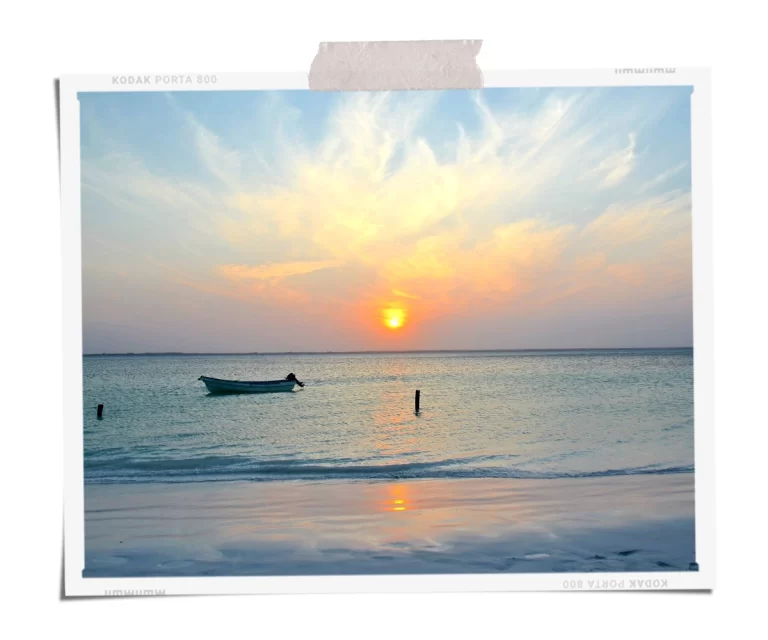
Your Complete Zanzibar Travel Guide
and why you should visit Zanzibar soon!
Have you heard of the exotic island Unguja – referred to informally as Zanzibar? This tropical paradise is ~35 km (22 miles) off the coast of Tanzania, East Africa, and a semi-autonomous constituent state of the Union State of Tanzania.
So, why should you visit soon? Because Zanzibar has become a more popular destination in recent years tourism will only increase. To explore the island while it’s still authentic and not overrun with tourists now is your chance. Zanzibar is one of Africa’s most popular beach destinations for good reason!
The Zanzibar Archipelago consists of many small islands and two large ones: Unguja and Pemba. Unguja is over 200 km from north to south and around 100 km from east to west. The capital city of Zanzibar City is located on the island of Unguja and its historic center, Stone Town, is a UNESCO World Heritage Site.
Zanzibar’s main industries are tourism, spices, and raffia. Before the rise of tourism, the spice trade was the most important industry, which is why the Zanzibar Archipelago is also referred to as the “Spice Islands”.
Another important economic activity is fishing and algaculture. Besides the important marine ecosystem, the land ecosystem of Zanzibar is home to the Zanzibar red colobus monkeys, Zanzibar servaline genet, and the rare or now even extinct Zanzibar leopard.
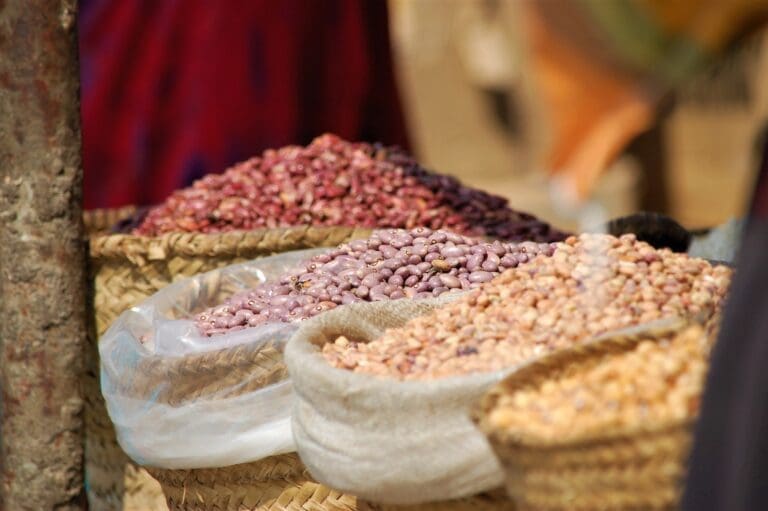
Mathias Katz
The history of the Zanzibar Archipelago has been eventful
Zanzibar played an important role in the trade flows of the Indian Ocean. Persian traders settled in the 10th century on Zanzibar and in the following centuries, Arab influence, especially from Oman, continued to increase. The population is still influenced by these diverse cultures today. The 14th century marked the beginning of European influence when Zanzibar became part of the Portuguese Empire. It remained under the ownership of Portugal for two centuries.
At the end of the 17th century, Zanzibar came under the influence of the Sultanate of Oman. After the Sultan of Oman moved his seat of government to Stone Town in 1832, the city became the most important hub for the slave trade on the East African coast. Farming cloves and coconuts were the other significant economic activity at the time.
Under the rule of Sultan Bargash, the slave trade was finally banned due to the pressure of the British Empire. In the late 19th century Zanzibar became a British protectorate. After a bloody revolution of the black majority population against the upper class of Arab origin, Zanzibar declared itself independent on December 10th, 1963. On January 12, 1964, the People’s Republic of Zanzibar and Pemba was proclaimed. Three months later, Zanzibar and independent Tanganyika initially merged, and in November the republic was renamed the United Republic of Tanzania.

Cody McLain
The Zanzibaris
The approximately 1 million inhabitants of Zanzibar are of various ethnic origins and the population consists of ethnic Swahili, Bantu population of sub-Sahara Africans, and also several Arabs, Persians, Somalis, and Indians. The majority of the population is Muslim with a Christian minority as well as other religious groups. The inter-religious body “the Joint Committee of Religious Leaders for Peace” was established in 2005 with representatives from all major religious congregations.
The official languages are Swahili and English. However, the lingua franca in much of East Africa including Zanzibar is Swahili. Arabic is also spoken in many areas. In tourist areas and hotels, other European languages like French and Italian are often spoken as well.
Tourism
Since tourism is economically very important for Zanzibar, the safety of travelers is a top priority for the local authorities. It is also safe to travel alone as a woman as the Zanzibarians are very friendly, helpful, and polite. The Zanzibar International Airport is in Zanzibar City and is relatively small and not very modern. It is easy to find private transportation to the hotel for a reasonable price. The roads are pretty well maintained in the city and larger villages but smaller roads can turn to dirt roads quickly. While it’s possible to rent a car, we would not advise it. Also, the public transportation system (Daladala) in Zanzibar is very cheap and technically connects most towns, but, the buses, or rather old vans, do not run on a set schedule and it’s impossible to book tickets in advance. We would not advise taking the sometimes unreliable and very packed public buses.
Similar to other developing nations, tourism is great for Zanzibar’s economy, however, not necessarily for the general population or ecosystems. Mindful travel is particularly important here to not contribute to the problem. Some things to keep in mind are choosing hotels run by locals rather than large corporations, making sure the excursions operate sustainably and the local communities profit from it as well that the wildlife and nature are protected and not destroyed. And of course, leave no trace. Zanzibar has had problems with increased volumes of trash and no effective waste (recycling) system.
How much does a trip to Zanzibar cost?
Of course, this depends on what kind of accommodation you choose and from where you’re traveling to Zanzibar. Flights from Europe are around around 900 – 1300 Euros (Nov. 2022), with direct flights from Amsterdam and Paris (travel time approximately 9 hrs). Flights from the U.S. are between $1000 – $1500 with 1-2 stops and a total duration of 20+ hours. The pre-pandemic flight prices were around 30-50% lower! Hopefully, we’ll get back to these prices eventually.
Hotel prices start as low as 30 Euro per night with a nice beach resort and the average price for a 3-star hotel is 60 Euro per night. Food, drinks, transportation, and excursions are very affordable and fairly priced. Most hotels offer breakfast or half-board options. There are, of course, also some stunning 5-star hotels available on the island and compared to e.g. the Caribbean usually a very good deal.
How many days do you need in Zanzibar?
We would suggest 10 – 12 days to have enough time to relax and explore the island, particularly because the travel time is on the longer side. However, it is possible to see everything in 1 week. Oftentimes, people visit Zanzibar after a safari in Tanzania and spend another 4-6 days on the island to mostly relax on the beach. The flight from Dar es Salaam, Tanzania only takes about 20 minutes. It’s also possible to take a ferry. Flights from Kenya or inland Tanzania are also possible.
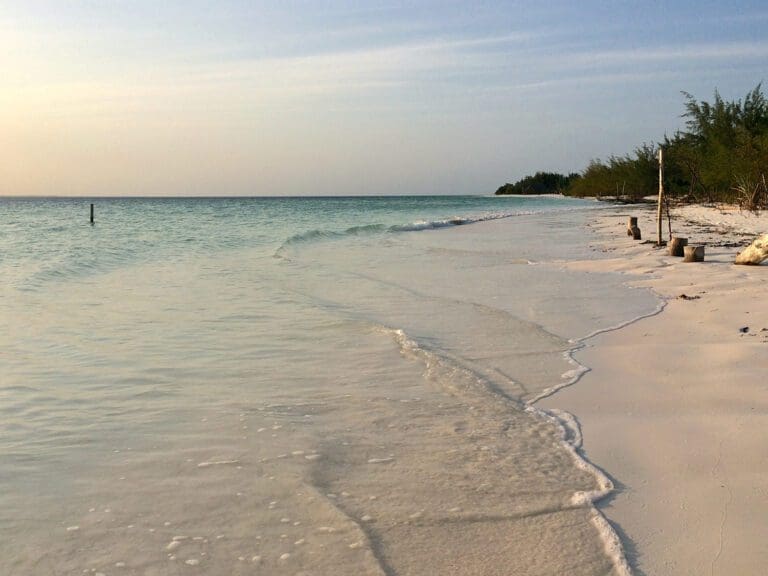
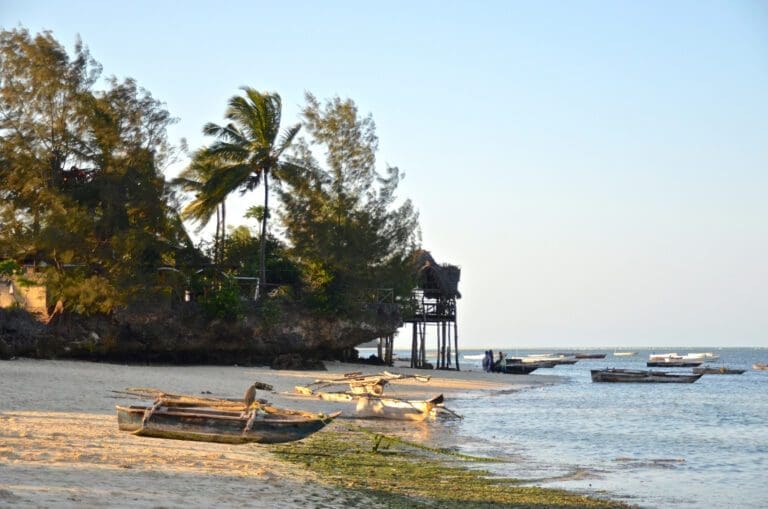
What is the best time to travel to Zanzibar?
Due to its proximity to the equator, Zanzibar has a tropical climate with maximum air temperatures between 29 and 32 degrees Celsius. Even at night, the thermometer does not drop below the 18-degree mark throughout the year. Therefore, Zanzibar is a year-round destination.
The dry season is from July to September and most popular time to visit. The shoulder seasons of June and October are also a great time to visit Zanzibar. The June to October travel period also coincides with the peak season for safaris in Tanzania. April and May are monsoon seasons, and November, December, and March can also see more rain. The hottest month are also November through April.
Heads up: this post contains affiliate links. If you click on an affiliate link and make a purchase, you won’t pay a penny more, but we’ll get a small commission, which helps keep the lights on. Thanks!
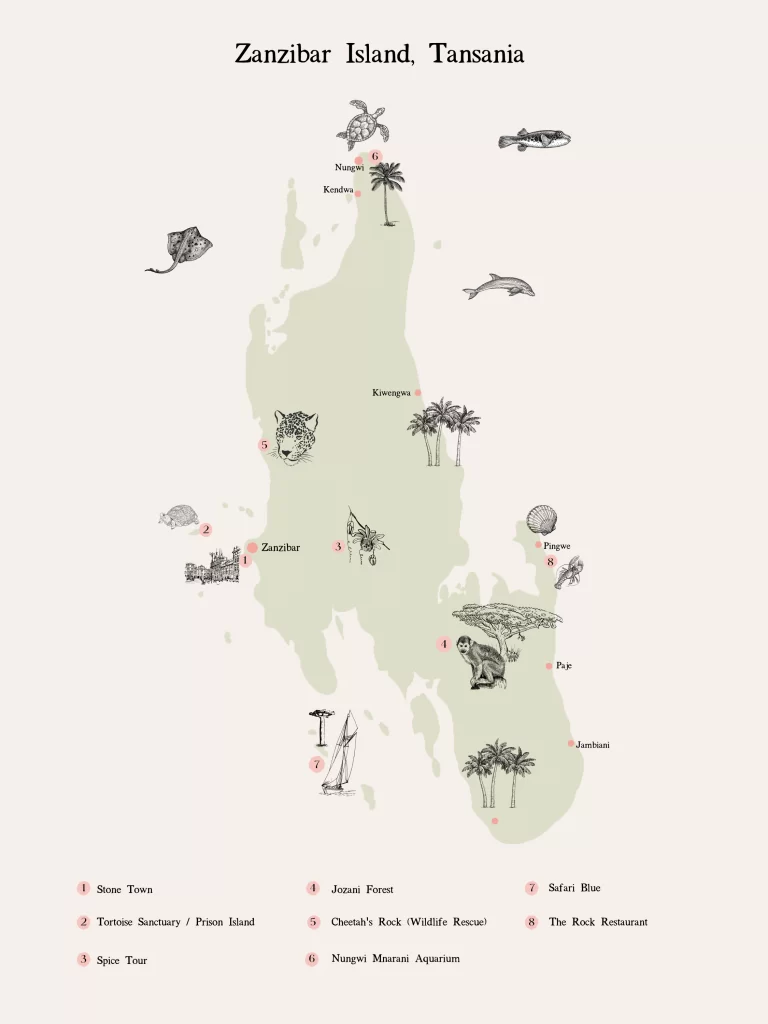
Where to stay in Zanzibar?
Zanzibar has a few popular areas with some of Africa’s most beautiful beaches. On the east coast, some of the most beautiful beaches and hotels are in Kiwengwa. Coral reefs and sand bars can be found along the east coast of the island and tide pools become visible during low tide. Swimming is often not possible during low tide here.
The best hotels in Kiwengwa:
Traveler’s Choice 2023: Mvuvi Boutique Resort
Top hotel: Bluebay Beach Resort & Spa
Great value for money: Lapili Residence
In between the central coast and the southeast coast is a little peninsula with the village of Pingwe on the east side, and Michamvi on the Chwaka Bay (inland) side. The peninsula is less crowded and has untouched natural areas. Michamvi beach has incredibly powdery white sand and most boutique (mid-to upscale) hotels can be found here. However, the tides are also quite drastic. On the bright side, you can catch some of the most breathtaking sunsets on Michamvi Beach.
The best hotels in Michamvi
Our absolute favorit: KonoKono Beach Resort
Luxury: Le Mersenne Zanzibar, Autograph Collection
Great deal: Michamvi Spirit Lodge
Boutique Hotel: Upendo Beach Boutique Hotel
Further down south on the east coast are Paje and Jambiani village, also very popular and beautiful beaches. Here, the tides don’t affect swimming as much as on the central east coast. Paje is the kitesurfing capital from December to February.
The best hotels in Paje & Jambiani
Boutique Hotel: Amani Boutique Hotel
Top value for money: The Loop Beach Resort
Traveler’s Choice 2023: Passion Boutique Hotel Zanzibar (adults only)
Extraordinary: Zanzibar White Sand Luxury Villas & Spa (Relais & Chateaux)
In the north, Nungwi and Kendwa are possibly the favorite areas of most visitors. Stunning beaches, less extreme tides, and less seaweed than in the other regions. Most large (luxury) resorts can be found in Nungwi and it’s quite busy during the high season. This is more for people who prefer all-inclusive large resorts. Kendwa is a bit less crowded and slower-paced.
The best hotels in Nungwi & Kendwa
Best Seller: Hotel RIU Jambo
Exclusiv: Zuri Zanzibar
Extraordinary experience with top ratings: Kilindi Zanzibar
Traveler’s Choice 2023: Nungwi Beach Resort By Turaco
Best value: Sandies Baobab Beach Zanzibar (Traveler’s Choice 2023)
On the west coast, Stone Town is the area where most people spend some time. There are not a whole lot of hotels along the west coast. On the south tip of the island, Kizimkazi is less developed touristically but still offers some great accommodations. It’s a top location for nature and marine life like bottlenose dolphins.
The best hotels in Stone Town
Best value/affordable:
Tembo House Hotel
The Seyyida Hotel & Spa
Kisiwa House
Luxury: Park Hyatt Zanzibar
Great deal: Kholle House
Boutique hotel: Upendo House Hotel
The best hotels on the west coast & Kizimkazi
Zanzi Resort
Chuini Zanzibar Lodge
Aya Beach Resort
Honorable mentions (other locations):
TOA Hotel & Spa
The Island – Pongwe Lodge
Zanzibar Retreat Hotel
Xanadu Villas & Retreat
Chumbe Island Coral Park
Diamonds Mapenzi Beach
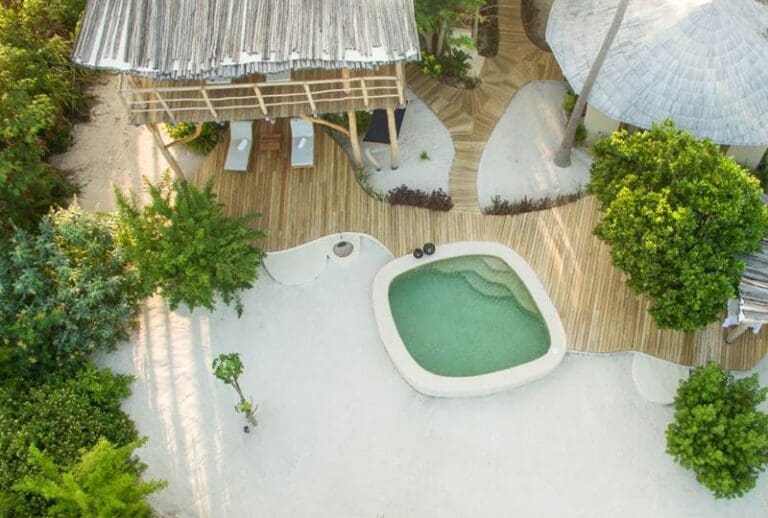
ZANZIBAR WHITE SAND LUXURY VILLAS & SPA

Elewana Kilindi Zanzibar
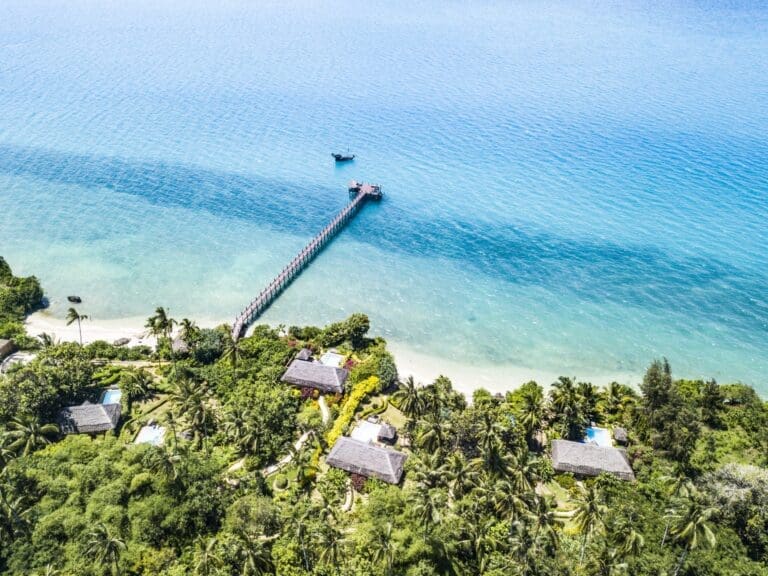
Zanzi Resort
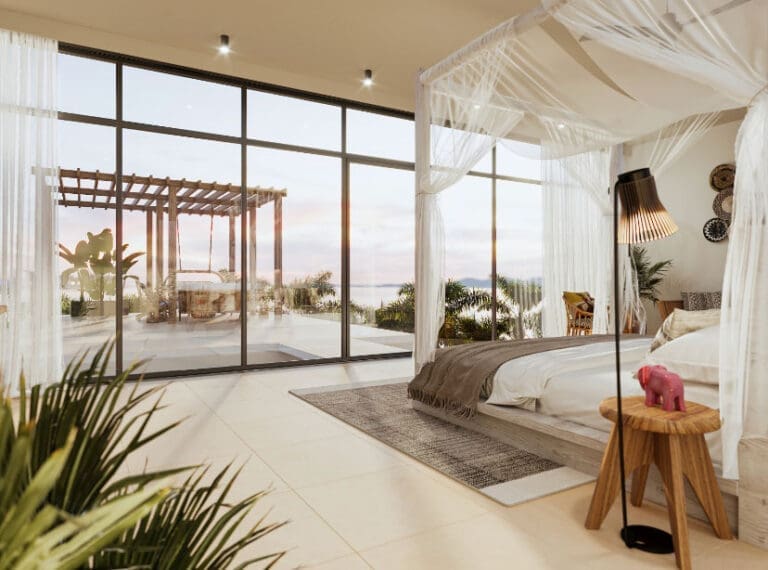
TOA Hotel & Spa
Best things to do on Zanzibar
There is so much to do here! This list is by no means exhaustive but we’ve personally tried most things on this list and had amazing experiences. Let’s start in the capital city.
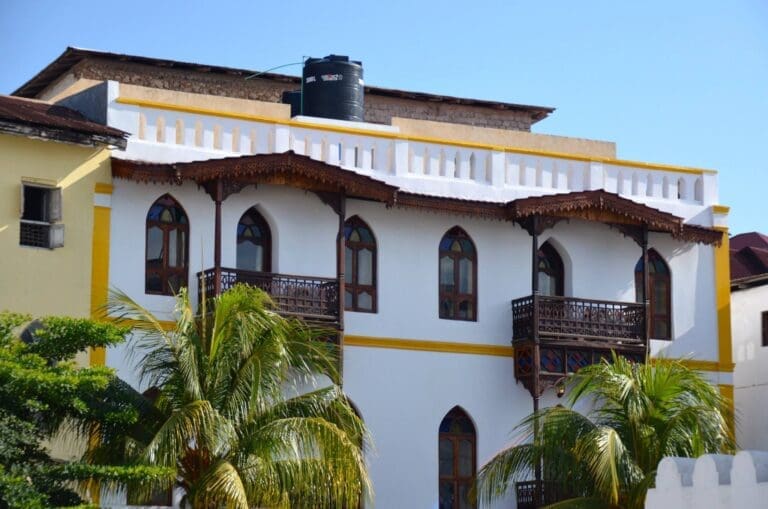
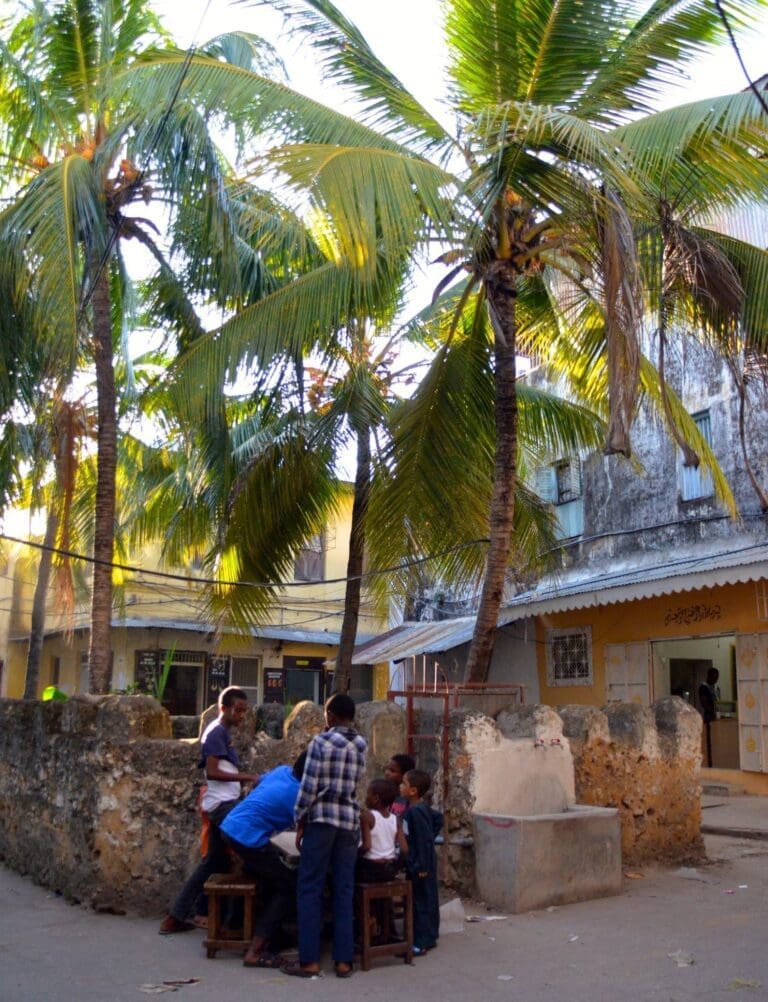
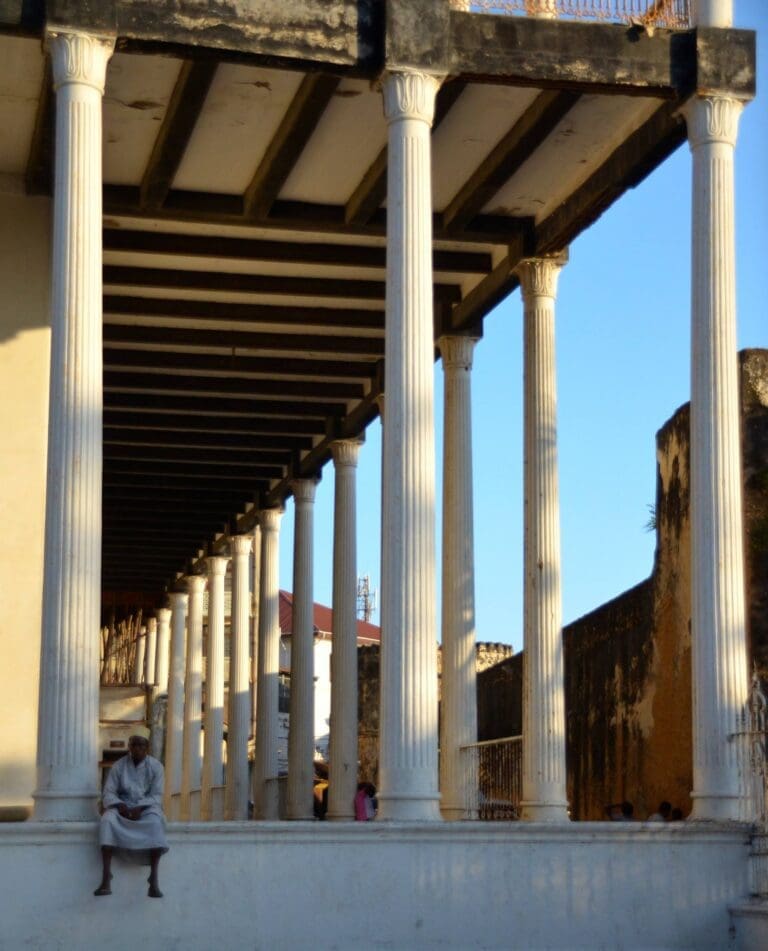
Stone Town
Stone Town is the oldest district of Zanzibar City. The name is derived from predominantly representative buildings and residences constructed of light coral limestone from the 1830s onward. From 1840, Stone Town was the residence of the Sultan of Oman. The ornate Swahili doors are the legacy of Indian traders from Goa, and the bullfighting on Pemba is the legacy of Portuguese colonizers. The wealth of fascinating architectural styles and cultures made Stone Town’s old town an UNESCO World Heritage Site since 2000. Stone Town is t can be easily discovered on foot and there are great walking tours available where you learn about the history, architecture, culture, and food – they usually end on a street food market.
A visit to Stone Town is often combined with a visit to Changuu Island.
Tortoise Sanctuary / Prison Island
Changuu Island (also known as Prison Island or Quarantine Island) is a small island 5.6 km northwest of Stone Town. It can easily be reached with a small boat and tours leave directly from the small natural harbor in Stone Town.
The island is approximately 800 m long and 230 m wide and was used in the 1860s as a prison for rebellious slaves and as a coral mine. Not only do you have the opportunity to enjoy a gorgeous beach where you can swim/snorkel and see stunning colorful starfish, but you can also visit the old prison buildings.
Another highlight is the giant tortoises’ sanctuary, which around 100 rare tortoises call home. In 1919, the British governor of the Seychelles gifted Zanzibar four Aldabra giant tortoises. Over the years, the numbers increased to up to 200 but due to poaching and being sold, the number dwindled to 7 at one point. Now they’re listed as vulnerable steadies and protected by the Tortoise Foundation.
Under the guidance of a tour guide, it is in some instances possible to feed the tortoises and get up close. The numbers on their shells are the age of the tortoise – the Aldabra tortoise can live up to 200 years!
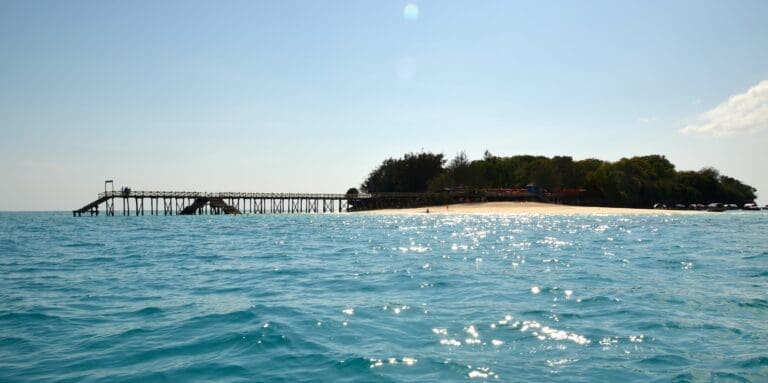


Jozani Forest
In the south of the island is the Jozani Forest also known as The Jozani Chwaka Bay National Park. The national park covers an area of around 50 square kilometers (19 square miles) and is located south of Chwaka Bay. It is home to incredible flora and fauna, most notably, the red colobus monkeys native to Zanzibar, Sykes monkey, bushbabies, over 40 species of birds, and more than 50 species of butterflies. The Zanzibar leopard is reportedly extinct and therefore reached mythical status and locals call it “Chui”. But who knows, maybe you’ll spot it on the national park tour.
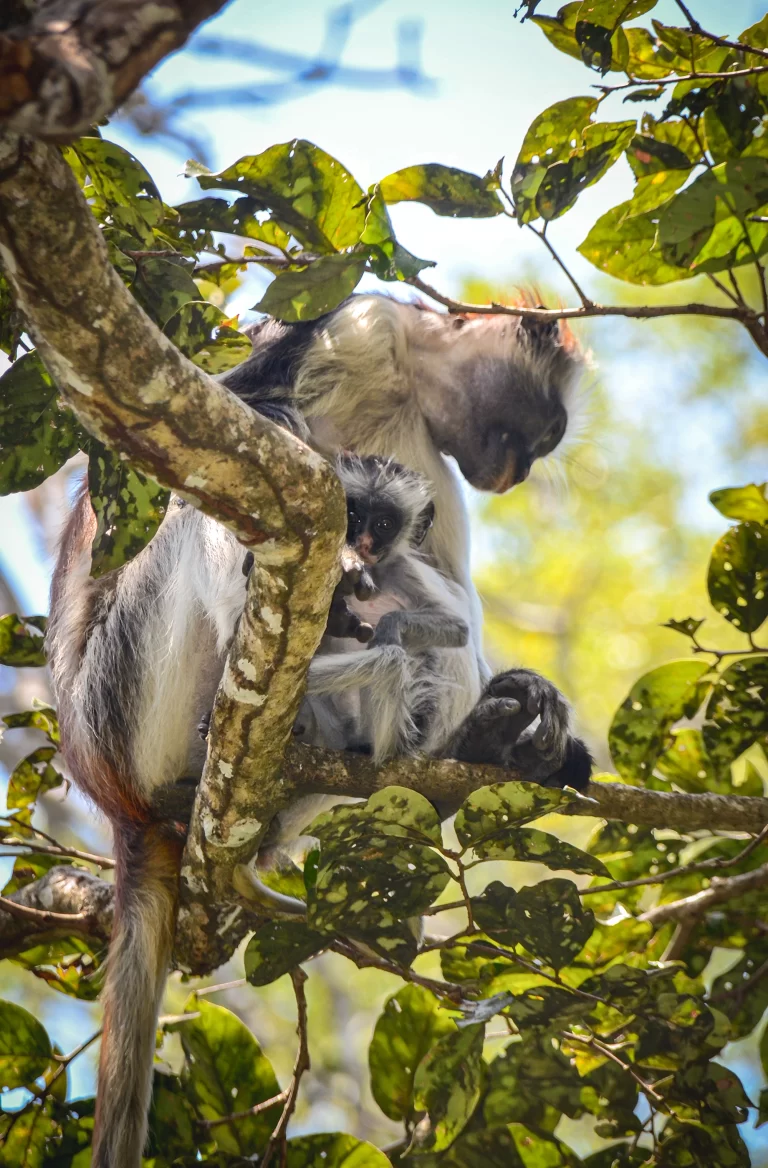


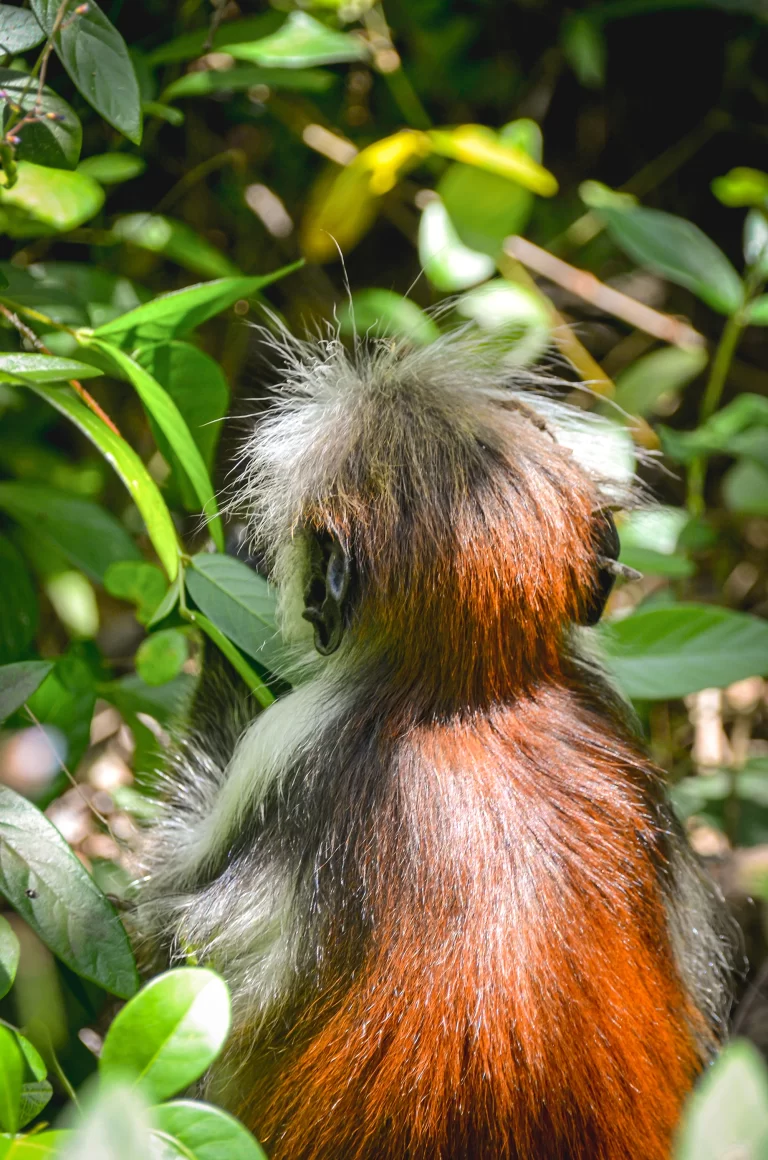
The Jozani forest is a great example of ecotourism done right. From 1995 to 2003, CARE International sponsored a development project for the wilderness area and the surrounding communities. The revenues from park entrance fees have been shared with local health clinics and the construction of schools. Furthermore, the number of visitors per day/tour is limited and the park rangers are very adamant to preserve the national park and educate visitors. While the red colobus monkeys were once considered endangered, the conservation project has since reversed this threatening trend and now the forest is home to over 6000 monkeys!
After walking through the tropical rain forest and seeing the lovely monkeys and other native wildlife up close, the trail, which is partly a boardwalk, through the mangroves takes you across the swamp where, depending on water levels, you may see tropical fish native to the Indian Ocean swimming among the mangroves and see crabs walking across the mud. The park ranger who will lead you along the nature trail will also point out the different plants and explain their medicinal properties.
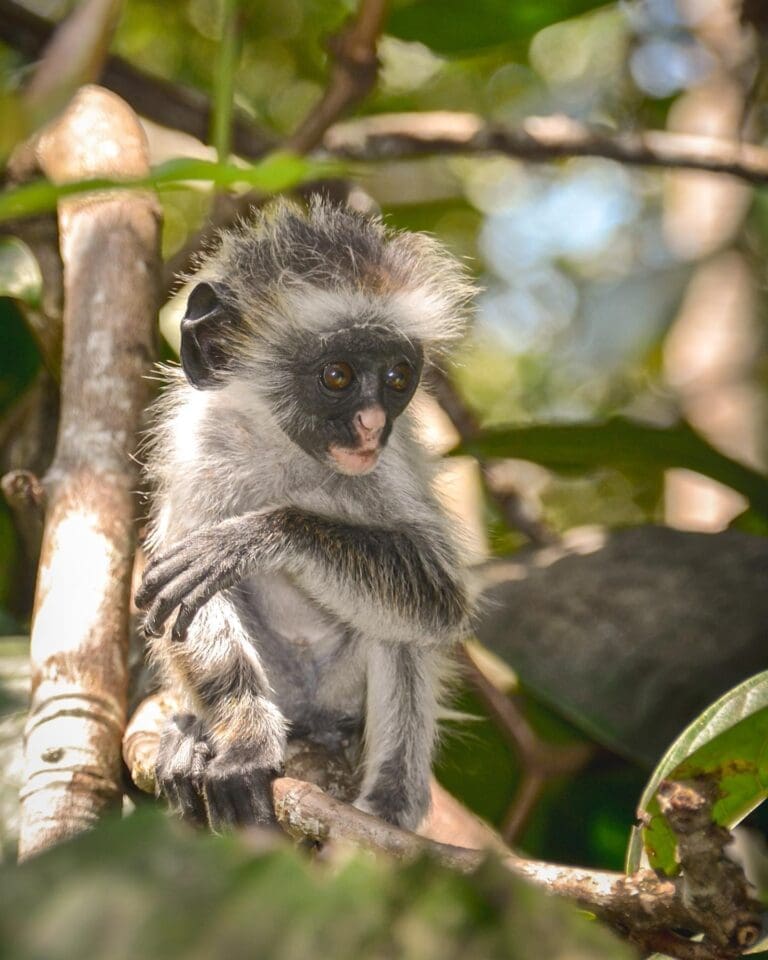
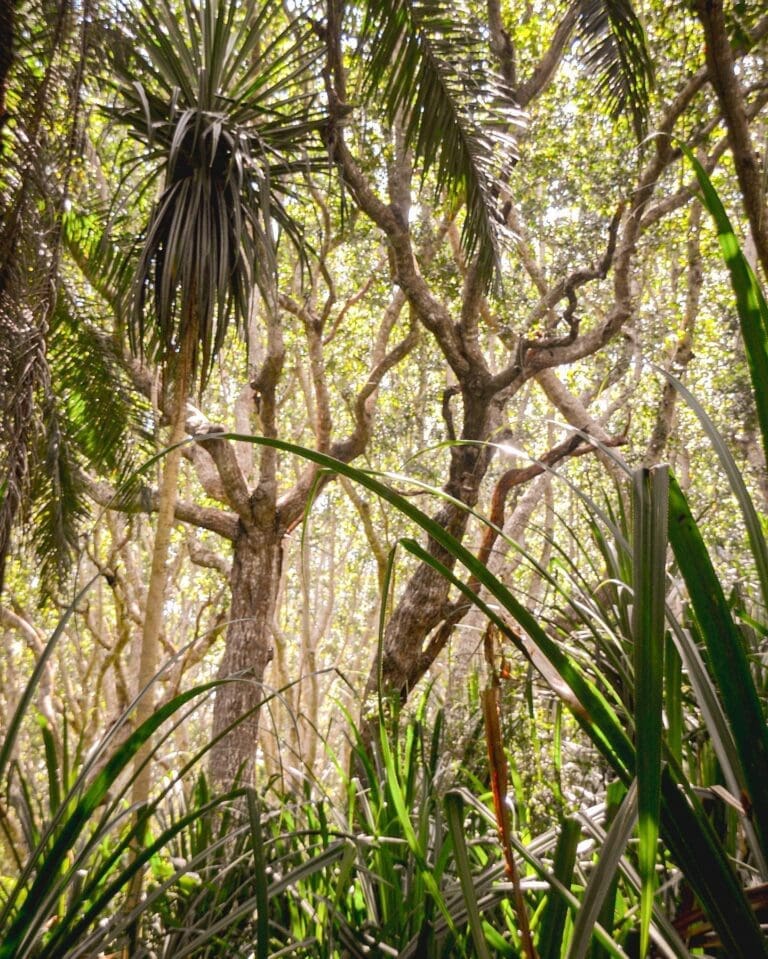
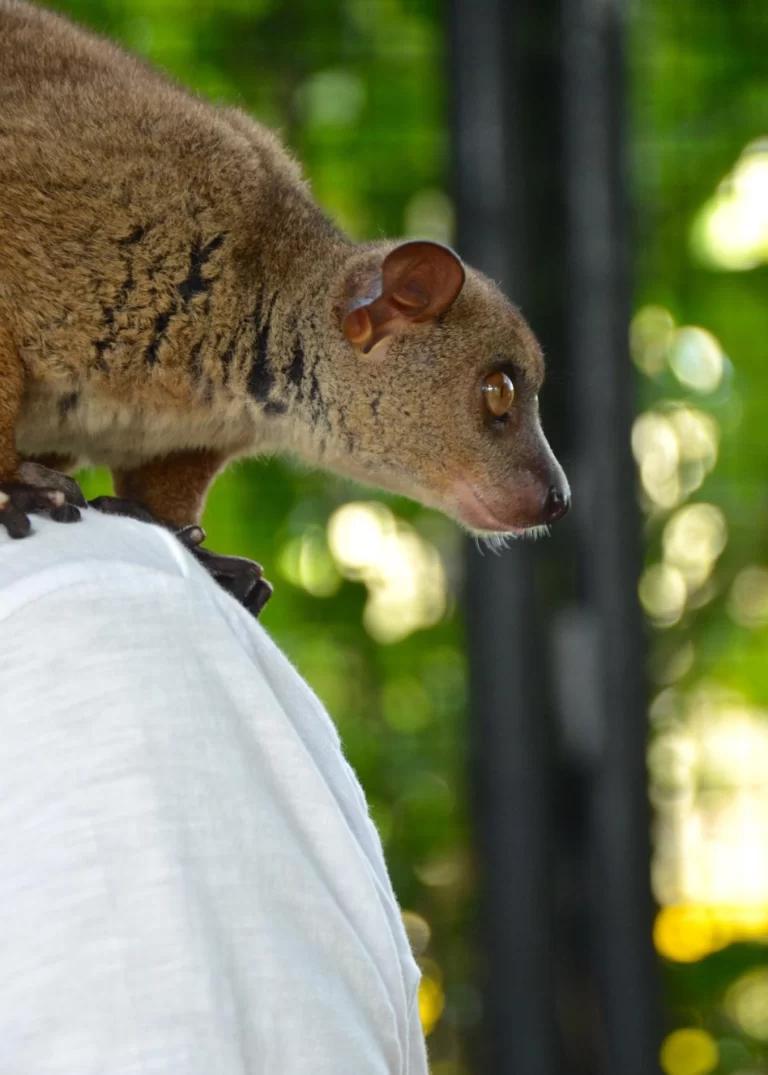
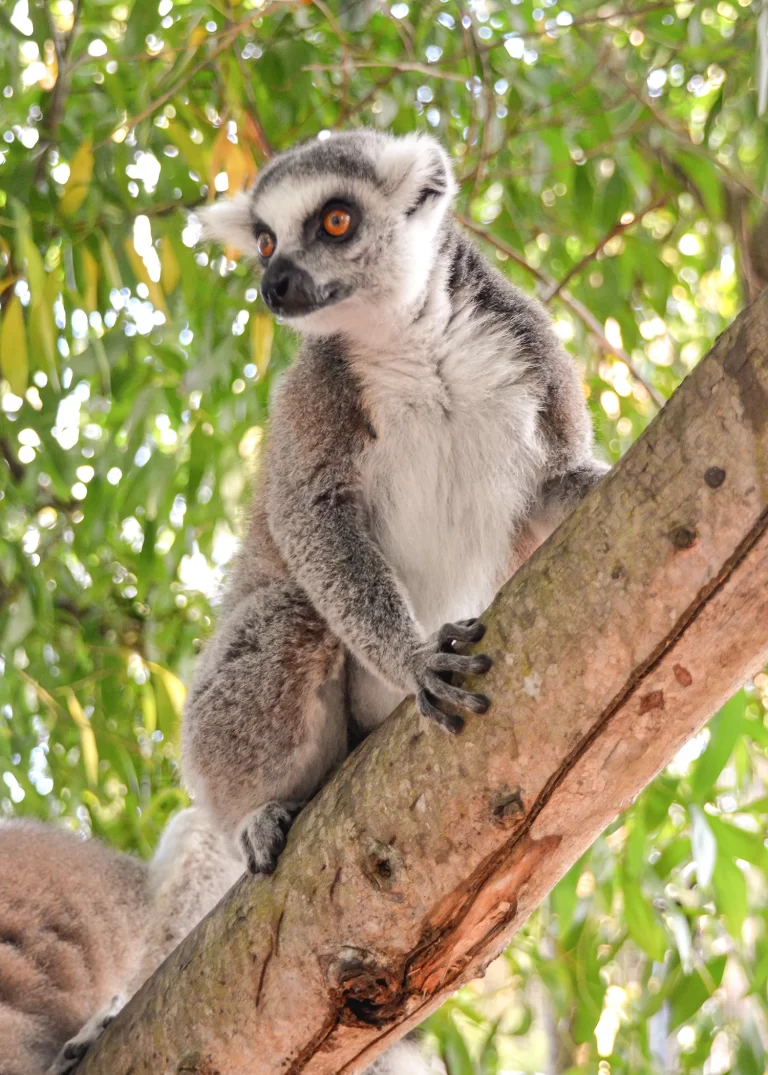

Cheetah’s Rock
Cheetah’s Rock is a very unique and special place and it was a truly memorable experience for us. First and foremost, Cheetah’s Rock is an ethical rescue and conservation center. They rescue wild animals and work tirelessly to give them the life they deserve and if possible release them back into the wild eventually. This wildlife tour is unforgettable and you’ll learn so much about the different animals at the sanctuary and also have the opportunity to meet some of them face to face, and interact with them. The bush babies completely stole my heart (picture above). Tours can be booked directly with Cheetah’s Rock and they include transportation. Of course, your entrance fee goes towards wildlife conservation.
The Rock Restaurant
This restaurant is not only famous but also one-of-a-kind! Situated on a rock off the coast and surrounded by water during high tide, this restaurant gives new meaning to sea-to-table dining. The freshly prepared seafood is absolutely delicious. The dishes are traditional Swahili with Italian inspiration. The Rock came a long way from a fisherman’s outpost to a fine dining experience. Reservations (long in advance) are a must and tables can be booked online.


Patrick Mueller
Safari Blue
The Safari Blue Tour is a relaxing, and at the same time, exciting full-day tour. The tour with a traditional Dhow (small boat) starts in the fishing village of Fumba. With a guide on board, you will head towards the first stop of the tour – a sandbar in the middle of the ocean which invites you to relax, swim and snorkel. Next, the dhow will sail to a mangrove lagoon and then on to Kwale Island where a Swahili seafood barbecue is served. Kwale Island is tiny but there are a few stalls where local women sell handcrafted sarongs and jewelry. There’s also a small beach bar and an old and very large Baobab tree can be visited and climbed.


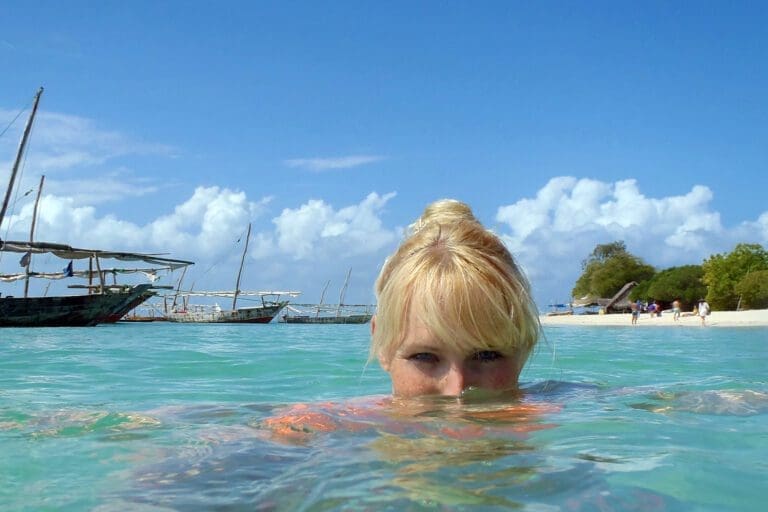
Humphrey Muleba
Dhow Cruise
Dhows are traditional East African boats that have been used for millennia and were either invented by Indians or Arabs and used primarily for trading and fishing. Traditionally, these Dhows are wooden with one sail. Dhow cruises are offered all over the island and particularly sunset cruises from Stone Town are very enjoyable with stunning views.
Jambiani Village
Visiting Jambiani village is a great opportunity to experience the rural life in Zanzibar and meet local farmers and craftsmen. On this walking tour, you’ll learn more about the production of local products and resources as well as daily life and Zanzibarian cuisine. Oftentimes, these tours also include a local lunch. It’s advised to choose the tour company carefully to make sure the tour is ethical and the villagers profit from it and are not exploited.
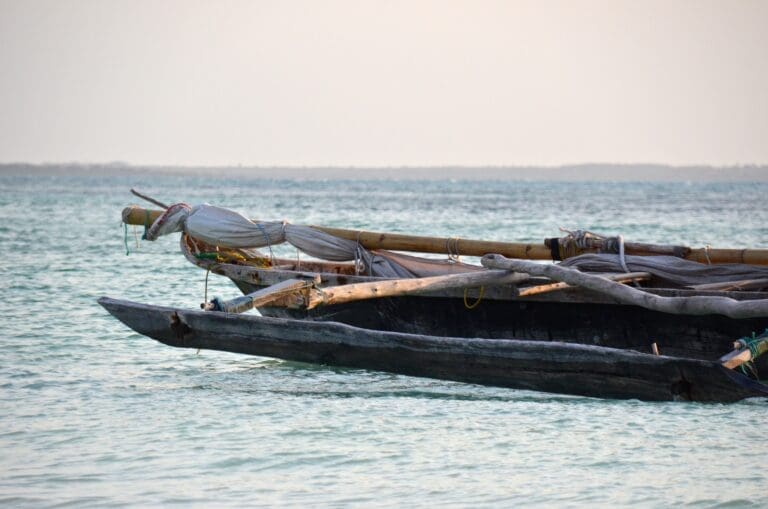
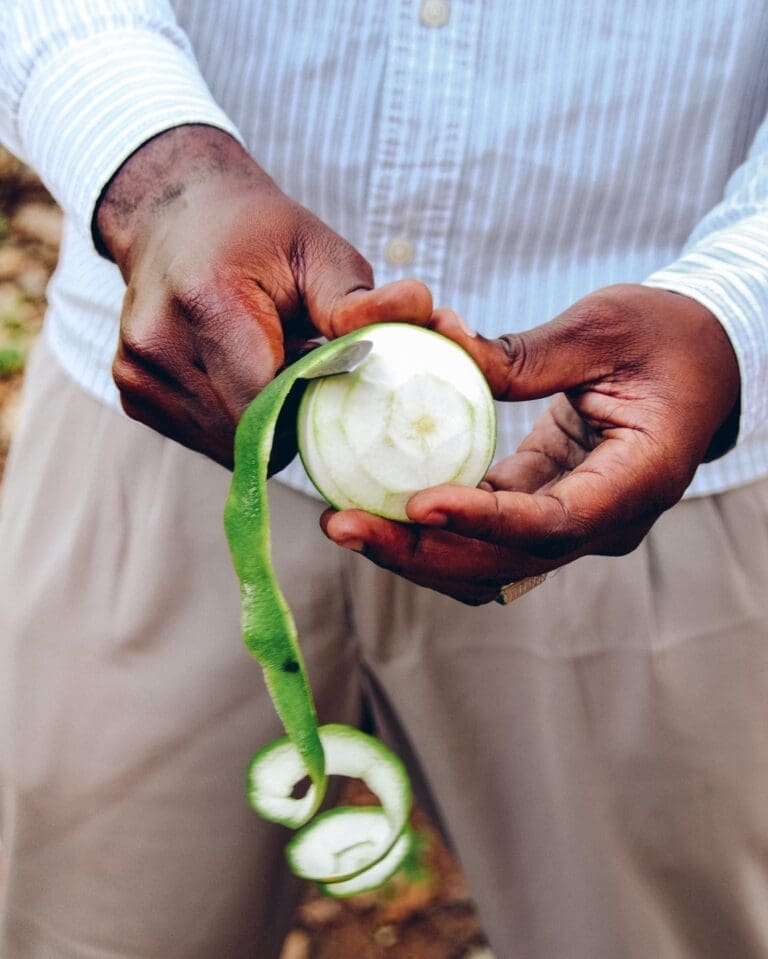
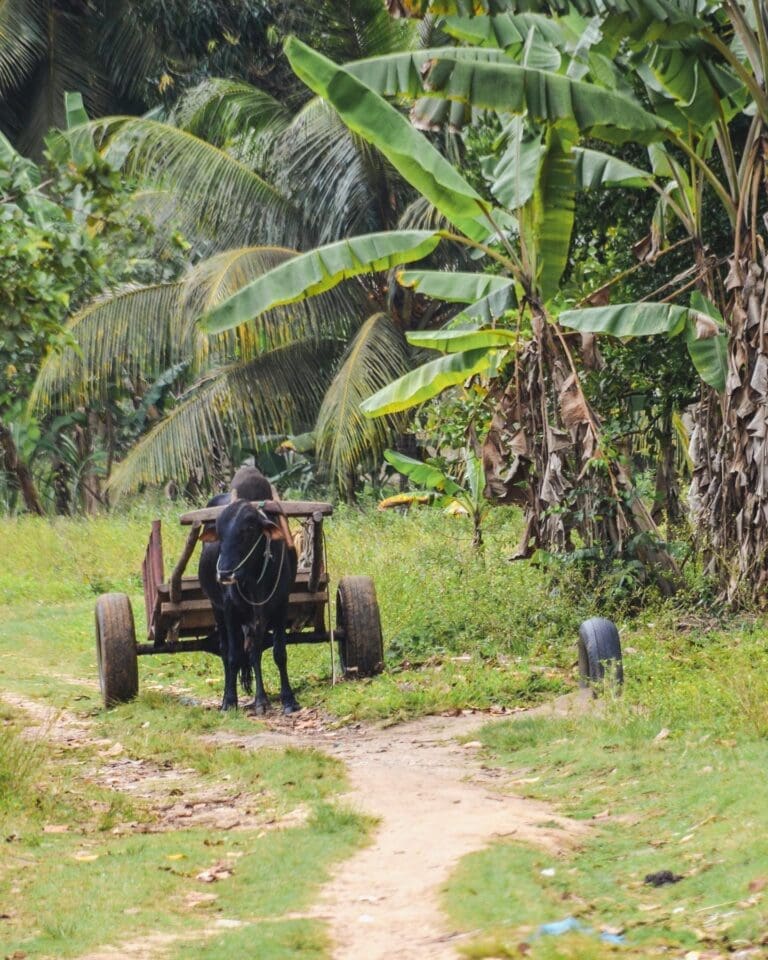

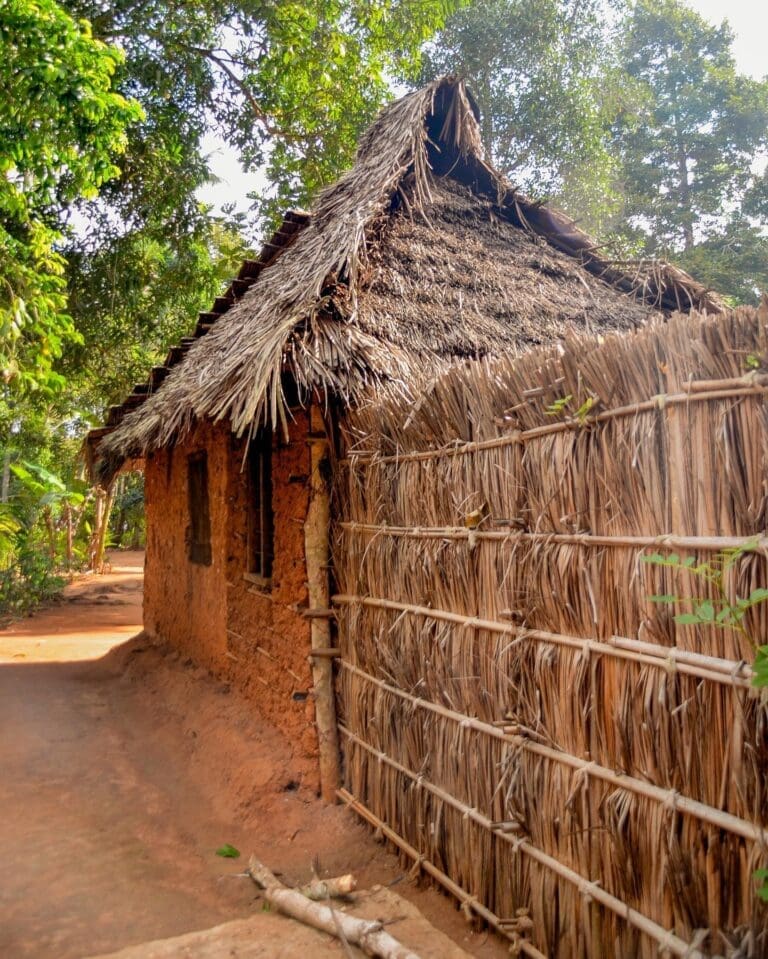
Spice Tour
The Spice tour is probably the most famous tour in Zanzibar, and at first, seems a bit touristy but it is actually well worth it and a sustainable and ethical tour. This wonderful excursion allows you to discover different types of spices, how locals live, grow and harvest spices/fruits and how these spices are used and prepared. Zanzibar is famous for spices and while the spice trade has been decreasing and is not as economical anymore, these tours substitute the income of the farmers.
The spice tour usually takes around 2-3 hours, during this time, you’ll walk at a leisurely pace through the spice plantation in the Masingini Forest and come across small villages. The guide will teach you about the different spices and fruits that are grown and you’ll have a chance to taste/touch/smell a variety of them. If you’re just a little bit interested in where ingredients you use when you cook come from and how they’re grown and prepared – this tour is for you. The plantations you’ll see are specifically grown for the tours to have everything close together while the actual crop-producing large plantations are in the surrounding areas. Most tours also offer a small local lunch prepared with many of the items previously seen. It’s delicious and great fun. We would recommend booking with local tour operators and a small group for the best experience.
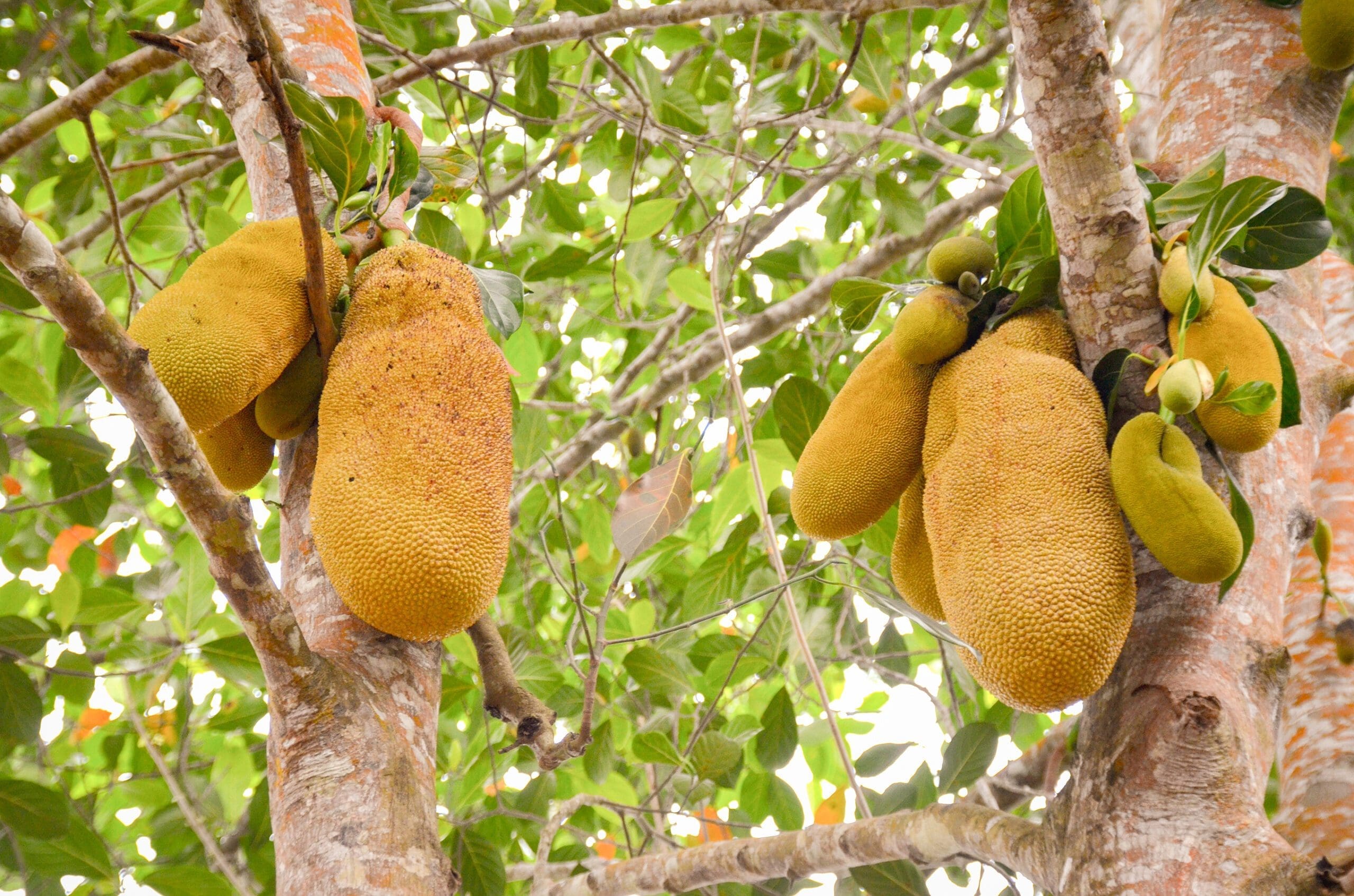
Diving / Snorkelling
Basically, you can snorkel almost everywhere on Zanzibar. For scuba diving, it’s likely not the best place in the world, but particularly the Mnemba Atoll in the northeast offers stunning marine life and crystal clear waters.
Word of caution:
Dolphin swim tours are offered in several places, unfortunately, they are not ethical, harm the dolphins and marine wildlife, and quite frankly can be dangerous for the participants as well. Most tours start at Fumba Island or Kizimkazi. While you probably will see wild dolphins, those dolphins are being chased by numerous boats for a prolonged period of time while they’re trying to hunt. Jumping into the choppy water with boats circling and struggling to get back on the boat is quite dangerous for the participants. The dolphins pass very quickly and at a distance in relatively dark/deep water.
Village tours that include visits to schools and/or hospitals are also to be chosen with great caution, to not fall into the “poverty tourism” trap where children are presented to receive donations that are in the end not used to fund e.g. schools.
Things to know before you visit Zanzibar
- Zanzibar’s currency is the Tanzania Shilling (TZS). Most hotels and stores quote and accept USD and more often Euro, too.
- In smaller local restaurants only shillings are accepted. Hence, it’s good to have a small amount of local currency as well.
- These days, many places accept credit cards but there might be a 5% surcharge.
- It is recommended to take cash with you – preferably freshly printed USD, Pounds Sterling, or Euros. ATM fees are very high.
- The best place to exchange currency is in Stone Town.
- Entry visas are mandatory for most Western travelers. They can be purchased upon arrival for $50 or online in advance.
- Stick to bottled water for drinking as the tap water is chlorinated.
- If you have water shoes – bring them. Sometimes the ocean floor close to the beach can have old reefs, stones, and sea urchins.
- Zanzibar being predominately Muslim, it is highly recommended to dress respectfully. Beachwear is fine at the beach and resort but on excursions, particularly in Stone Town, clothes should be more appropriate – knees and shoulders covered, no short shorts or tops with a lot of cleavage. When on a boat/snorkeling excursion, of course, this is different.
- Leave valuables in the safe and don’t wear flashy jewelry.
- When walking on the beach during low tide (beach previously below water) beware of sea urchins.
- At markets, people usually actually don’t haggle.
- Markets are also a great place to buy spices for less than they’re sold in tourist shops.
- Plastic bags are banned! Bring a reusable canvas bag just in case you’ll go to a store.
- It’s prohibited to take shells and other organic matter out of the country.
Safety tips for solo female travelers:
Use common sense. No, seriously, Zanzibar is not more or less dangerous than other places as long as you follow basic safety measures. Beach boys are mostly harmless but don’t buy anything from them or interact too much. Dress more on the conservative side to avoid unwanted attention. Don’t use random taxis and don’t walk around Stone Town alone at night. Don’t tell everyone where you are staying.
Elaine Tu
Zanzibar Packing Tips
It is usually hot to very hot and humid throughout the year hence, the most important packing tip is to pack lightweight, loose-fitting clothes made of breathable materials like cotton and linen. A light cardigan or jacket is a good idea for cooler nights and indoor air-conditioning areas. Long-sleeves and long pants help to avoid mosquito bites.
The sun is very strong and cover-ups are recommended on boats or by the ocean to avoid sunburn. Cover-ups and light beach dresses will probably be your go-to items anyway. Staying with the beach theme – don’t forget your hat(s)!
Some higher-end hotels and restaurants require more formal evening wear – for example, long trousers. If in doubt, check with your hotel in advance.
Non-clothing items: an efficient mosquito repellent, a light rain cape, sunscreen, after-sun or aloe gel, basic first-aid kit (pain reliever., stomach related issues), water shoes, power adapter, sneakers, bag or backpack for excursions, reusable water bottle, canvas bag, earplugs.
Hopefully, we were able to inspire you to add Zanzibar to your travel destination list!
We would be happy to assist you with your travel planning!
If you’ve enjoyed reading this blog article, why not share it with your network?
Still looking for more inspiration? Why not read our blog about the Samana Peninsula, Dominican Republic

